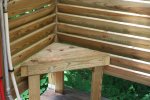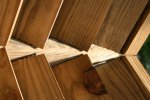I agree that using bromine tabs without a reserve is not the proper way to do it but do you know how many people aren't told that -MANY!
Adding bromine tabs and not having a reserve will give you a chlorine system - I agree - this is NOT a rehash. BUT you made it sound like I was giving wrong info. Spa covers and pillows can be ruined by both the chlorine if bromine is used wrongly and by bromine if used correctly. OK, I'll give you the fact that both bromine and chlorine won't happen in a properly run system.
As far as easy - I do participate on a different forum and people use the 3 step bromine system (when advised properly) and it seems that they constantly fiddle with the the settings on the dispenser and eventually either get it or get frustrated and turn to a different method. I will even go and say that every so often someone who successfully ran a bromine system and converts to dichlor and likes dichlor better and says it easier. And sometimes the reverse is true.
I certainly will say after giving it some thought that running on bleach would be a lot more time consuming than dichlor - but this is strict.ly my opinion.
As far as MPS - I looked onto the website and copied the info here. There is nothing that says it doesn't destroy CC as a matter of fact it suggests to use it instead of superchlorination on a weekly basis. This would indicate to me that it is used to get rid of CC - Please point me in the right direction. My knowledge of breakout chlorination and using MPS (oxone) seems to be about the same.
From the website:
Easy care for clean, sparkling water. Regular oxidation with Oxone® stops problems before they start.
Some pool owners view “shocking‿ as the corrective treatment that is used after problems occur in their pools and spas. When corrective action is required, chlorine is often used as the shocking agent. There are drawbacks to using excessive chlorine shock treatments, including foul odors; irritation and dryness of hair and skin; and bleaching and fading of the pool liners, painted surfaces, covers and bathing suits.
To avoid these problems, a preventive program that includes products containing Oxone® and an EPA registered sanitizer keeps pool and spa water sanitized, oxidized and balanced. DuPont™ Oxone® pool and spa oxidizer helps make pool and spa care clear and simple. You’ll spend more time swimming and less time working when you follow these four easy steps to fresh, clear, sparkling water.
Step 1. Maintain sanitizer residuals
Step 2. Oxidize with products containing DuPont™ Oxone®
Step 3. Test and maintain proper water balance
Step 4. Maintain filtration equipment
Step 1. Maintain sanitizer residuals at 1–4 ppm (parts per million) at all times to control pathogenic (disease-causing) microorganisms and protect swimmers from disease and infection. Be sure to use an EPA-registered sanitizer in your pool or spa.
For in-ground pools with automatic chlorinators, this is usually done by keeping chlorine tablets in the chlorinator and adjusting the flow control valve on the chlorinator to maintain the desired concentration of free chlorine in the pool water.
For in-ground pools without automatic chlorinators and for above-ground pools, this is usually done by adding granular chlorine every one to two days to maintain the desired concentration of free chlorine in the pool.
For spas, there are several different sanitizer systems. The most common systems are based on bromine chemistry, using either bromine tablets or a two-part system using granular or liquid sodium bromide and DuPont™ Oxone® pool and spa oxidizer.
Back to Top
Step 2. Oxidize with products containing DuPont™ Oxone® every week to control the buildup of nonmicrobial contaminants, which can cause water to become dull and cloudy.
It’s easy. Sprinkle products containing Oxone® powder over the surface of the water, slowly and uniformly, with the filter running. Because Oxone® dissolves quickly and is completely soluble in water, there’s no need to premix it. Add about two-thirds of the total dose over the deep end, following the dosage guidelines on the product label.
Note: The first time you use DuPont™ Oxone®, add a double dose to the water to ensure maximum elimination of any waste that may have built up.
Most people treat their pools and spas in the evening. That way, the next day, you can enjoy an early morning dip in fresh, clear, sparkling water. However, you can add products containing Oxone® to your pool or spa at any time and swim in 15–30 minutes in pleasant water — something you just can’t do with conventional chlorine shock treatments!
Remember, weekly oxidation is a preventive measure that keeps bather waste and other nonmicrobial contaminants at a minimum while allowing pool sanitizers to work at maximum efficiency, keeping pool and spa water sparkling clear.
Oxone® and chlorine
1. Is Oxone® a replacement for chlorine?
Not at all. Chlorine sanitizes the water and protects bathers against disease and infection. Using an EPA-registered sanitizer like chlorine is critical to maintaining pool water. Oxone® is an oxidizer that works in conjunction with the sanitizer to eliminate nonmicrobial contaminants and improve sanitizer efficiency.
2. Are Oxone® and chlorine compatible in pool and spa water?
Yes. In fact, because products containing Oxone® enhance the efficiency of sanitizing agents, they actually make chlorine work better and last longer in your pool. However, remember that you should always add each pool chemical to the water separately. Never mix any pool chemical with another one.
3. How does Oxone® work with chlorine sanitizers?
By eliminating nonmicrobial contaminants and reducing the demand on the sanitizer, products containing Oxone® allow the chlorine to sanitize pool water more efficiently.
4. Is Oxone® a better oxidizer than chlorine?
No, but it is more appropriate for pools and spas. Products containing Oxone® give you the positive benefits of oxidation without the drawbacks of high chlorine doses: reducing sanitizer efficiency, not eliminating all wastes and forming chloramines that produce unpleasant odors, irritate bathers' eyes and prevent you from using the pool for a lengthy period of time.
Products containing Oxone® eliminate contaminants rapidly while enhancing sanitizer efficiency, produce no irritating or odor-causing compounds, and allow you to enjoy the pool again within a very short time.
5. What are chloramines?
Chlorine reacts readily with many contaminants in pool water (perspiration, urine and other wastes) to produce foul-smelling and eye-irritating combined-chlorine compounds. These are called chloramines.
6. What is breakpoint chlorination?
It is the process of using a very high dose of chlorine to destroy ammonia. It is sometimes also known as superchlorination.
7. Does breakpoint chlorination reduce chloramines?
Breakpoint chlorination can remove free ammonia and monochloramine from water supplies, but it has a number of drawbacks.
First, it can be difficult to calculate the correct dosage needed to reach breakpoint accurately, and there is no guarantee that you will eliminate all combined chlorine compounds. And if you don't reach breakpoint, you may not eliminate any of them.
Second, the presence of organic nitrogen compounds in pool and spa water will interfere with the effectiveness of the breakpoint process and limit its ability to reduce combined chlorine levels to zero.
Third, corrective shocking with chlorine may keep you from using the pool or spa for a lengthy period of time due to excessively high chlorine levels.
8. Does Oxone® reduce chloramines?
Products containing Oxone® prevent chloramines from forming by oxidizing contaminants. Regular oxidizing with Oxone® keeps contaminant levels to a minimum, so the water remains clear and sparkling, allowing you to enjoy longer periods of uninterrupted swim time. And because Oxone® is chlorine-free, you don't have to worry about high chlorine levels; chloramines; unpleasant odors; or burning, irritated eyes.
9. When should I shock with chlorine?
If you use products containing Oxone® regularly and follow a recommended pool care program, you shouldn't need to conduct chlorine shocking at all. If your pool has been left untended for a long period of time, if chlorine residuals have not been maintained, or if algae growth is significant, it may be necessary to use chlorine shocking to kill algae and restore water quality.
The thing I don't understand is you are touting a system that you've helped many and it works but there are many knowledgeable people who tout a different system, they have helped many people and it works. This system was "developed" by Ben over at poolforum and is being practiced by the people here. I mentioned calcium and I was told "NO NEED TO USE CALCIUM" - I got that over poolforum. Ben (his system your using) said that if a vinyl pool has a heater you need to worry about calcium - years ago; at least thats what I remember. Dichlor is not BAD, the CYA situation was discussed by Chem Geek and myself and I appreciate his time. Are you the only true and right system - of course not. I originally came here to learn and thought people here have an open mind. Apparently not! Basically it seems that there is a "do what I say" mentality by some of the people here.
FWIW, I give out a lot of info myself and helped people with both pools and spas. I am not in the business but have learned through the years that somethings work and others don't. Most of what I learned about water care was from the poolforum but in reality the BBB is not the only system there is. Everyone who I have helped had a better experience with their pool or spa afterwards.



